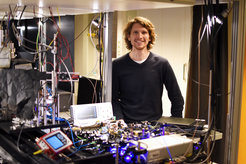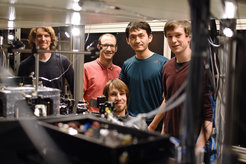Johannes Zeiher launches new research group
"Quantum Matter Interfaces" is the name of Johannes Zeiher’s newly established independent research group, in which he and his team investigate quantum matter for its application in quantum simulations and quantum computing with neutral atoms.
“Scalable Neutral Atom Quantum Computing”, or SNAQC for short, is the title and vision of the first project carried out in a newly established independent research group “Quantum Matter Interfaces” at MPQ. Its goal: to work on the technical hurdles that still make it experimentally impossible to freely programme and scale quantum computers today. Research group leader Johannes Zeiher was recently able to successfully acquire initial funding for his new project amounting to €3.3 million in the BMBF's (German Federal Ministry for Education and Science) junior researcher programme Quanten Futur. The aim of the project "SNAQC" is to carry out preliminary work towards the realisation of a first error-corrected logical qubit.

Error-corrected and scalable quantum computers are a key technology of the current "second quantum revolution" and promise great potential for applications in finance, logistics or quantum chemistry. One promising approach for the realisation of quantum computers is the construction of processors based on neutral atoms. This approach is being pursued at the MPQ by several groups, including that of Johannes Zeiher.
But regardless of the hardware underlying the quantum processor (superconducting qubits, trapped ions or neutral atoms): the widespread use of quantum computers is currently still prevented by errors in the execution of quantum gates, the elementary computing steps of a quantum computer. Excessive gate errors make quantum calculations unreliable, less valid and destroy the intended advantage of quantum computers for solving difficult problems. Quantum computers are currently still very susceptible to these errors. So-called quantum error correction offers an elegant way out of this dilemma: through continuous and controlled measurements, gate errors can already be detected during runtime and subsequently corrected. Nevertheless, the realisation of error-corrected quantum computers remains a mammoth task, since quantum error correction places very specific demands on the architecture of quantum computers.
From the NISQ architecture to a fault-tolerant regime

The declared goal of SNAQC is to develop a novel experimental platform for quantum computing based on neutral atoms and to take a first step towards quantum error correction. An important requirement of quantum error correction is the fast and non-destructive detection of qubits. In a system of neutral atoms optimized for quantum computing, SNAQC aims to achieve this with the help ofoptical resonators. Thus, the SNAQC project is leading neutral-atom quantum computers towards the transition from the NISQ architecture to a fault-tolerant regime.
NISQ computers (Noisy Intermediate Scale Quantum Computers) are the currently prevailing quantum computers that can effectively compute their tasks up to a maximum size of 50 qubits, even under the moderate tolerance of errors. They are the current "state of the art" of digital quantum computing, but still many stepsaway from the very big vision. In addition to fault tolerance, the scalability of neutral atom quantum computers is also an important prerequisite for the technology to continue maturing for practical and economically relevant applications.
With his new experimental platform, Johannes Zeiher methodologically forms a completely new link at the MPQ between the departments of Immanuel Bloch (Quantum Many-body Systems) and that of Gerhard Rempe (Quantum Dynamics). The microscopic control of individual atoms as well as the control of interactions between atoms with the help of highly excited Rydberg states is a great strength of Immanuel Bloch's department, while the strong coupling of individual atoms to light using optical resonators, to among other things non-destructively detect quantum particles, is right up the alleyof Gerhard Rempe and his department. Johannes Zeiher's group is one of the first in the world to combine these two different systems into a new method, building on many years of cutting-edge research at the MPQ in these two areas.
Further projects
In addition to SNAQC, Johannes Zeiher also leads other projects within Immanuel Bloch's group at MPQ. Last year, for example, after his return to the MPQ, he and his team began setting up an experiment for analogue quantum simulation with strontium atoms - the "Strontium Rydberg Lab" or "Sry-Lab" for short. What is new about this experiment is the combination of two different methods for controlling atoms in a vacuum - the optical lattice and optical tweezers - into a one hybrid platform. This combination has the decisive advantage that originally long cycle times of an experiment (approx. 20 to 25 seconds until the experiment is reinitialised due to long cooling times) can be reduced by a factor of 100 to 200ms and now many times more measurements can be performed per day. In quantum simulations, for example, this allows to detect extremely weak effects in the interplay of many quantum particles, which can lead to a better understanding of the simulated systems.
About Johannes Zeiher
Johannes Zeiher started his physics studies at the LMU Munich in 2007 and his first job at the MPQ as a working student in 2008. He subsequently completed a Master's degree at Cambridge University and a PhD at MPQ. He then held postdoctoral positions, also at MPQ and UC Berkeley, before returning to MPQ in mid-2020 to set up his own research group. There, he has been leading the experiment to study strontium Rydberg atoms since the beginning of 2021 and started the BMBF-funded project SNAQC within an independent research group in December 2021 with self-acquired funds and financially independent of the MPQ.













